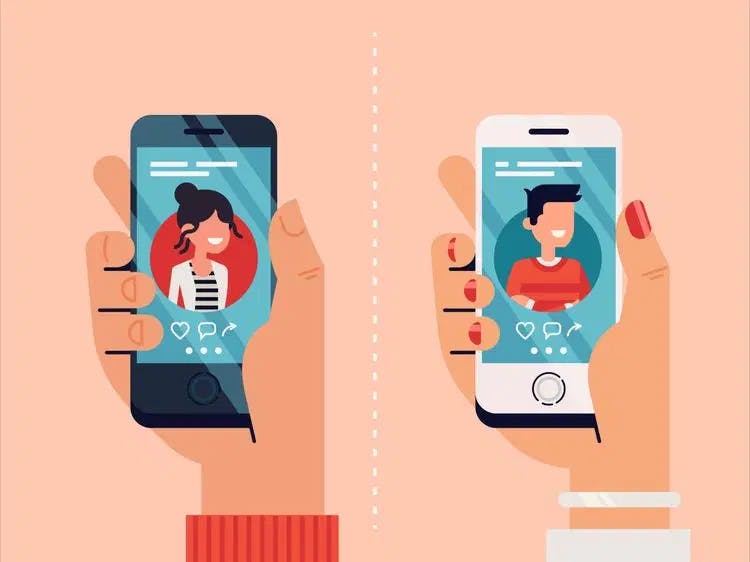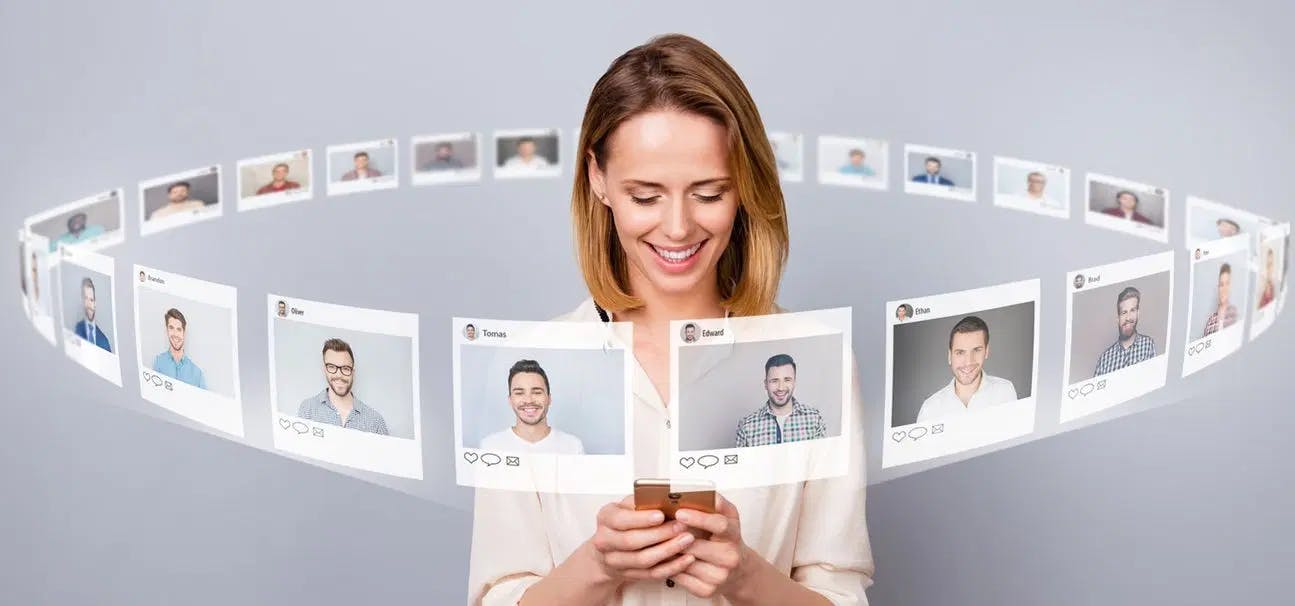
Amazon Rekognition: Recognizing Love
Gwenever Pacifico • Jan 26, 2021
3 minutes
Online dating has connected millions of singles around the world. And with dating apps embracing emerging technologies such as Amazon Rekognition, digital dating is changing not only who we match with, but how we match.
The first spark of technology-assisted romance started in a Stanford University classroom in 1959. Using questionnaires, punch cards and an IBM 650 mainframe computer, two students matched 49 couples for a class project.
Fast forward to the present day where, according to a 2019 survey by the Pew Research Center, 3 in 10 Americans have used a dating app and 12% have started a committed relationship because of one.
As more dating platforms are built, the digital romance market will continue to become increasingly competitive. With so many options to choose from like OkCupid, eHarmony and Zoosk, digital dating companies need to find a way to stand out.
Amazon Rekognition can help these businesses leverage deep learning technology to improve brand experience (BX). With its ability to detect, analyze and recognize features in images, Rekognition’s large scale data visualization can provide an efficient and accurate way to search and categorize a dating app’s massive collection of photos.
While there’s controversy regarding the privacy issues that facial recognition inherently brings up, it can provide the online dating world with faster results and better customer experience (CX).
Your Face: Swipe Right
Market research firm TechSci Research reports that the global dating apps market is expected to surpass $8.4 billion by 2024. With so much potential profit residing in online dating, it’s essential for matchmaking services to understand user needs. Amazon Rekognition can improve CX and BX by providing these apps with powerful visual analysis.
Many dating apps, notably Bumble and Tinder, allow users to match with each other based on a mere glance-and-swipe of a photograph. And there’s good reason for this. Tom Jacques, Chief Technology Officer at Tinder, says that the primary driver for whom a user matches with is photos. “We see it in the data: the more pictures you have, the higher likelihood of success to match.”
Tinder utilizes Rekognition to identify users’ key traits by mining the billions of photos that are uploaded to the app each day. Amazon’s machine learning services add personality markers to each of these billions of pictures. If a user is playing the piano in their photo, Rekognition will automatically detect the piano. This makes it easy to tag that person as “creative,” which then helps Tinder match that person with another “creative.”
When signing up for Tinder, a user normally posts photos of themselves and writes a short bio. But now that an increasing number of users are omitting the written bio, the algorithms built into the dating app must rely solely on photos as the basis for its match recommendations.
While being able to use technology to find the faces of people we’d most like to spend time with counts as a cyber success story, it fails to account for a wide range of complicated, very human concerns, such as deceit.

Source: Shutterstock.com
Bait and Switch: Stopping Fraud With Facial Recognition
With the sheer volume of people using dating apps, it’s easy for malicious behavior to go unchecked.
According to the FBI’s 2019 Internet Crime Report, 19,473 people in the United States reported being victims of confidence fraud and romance cyber crimes, aka catfishing, with victims losing over $475 million.
The bait and switch of catfishing isn’t solely an American phenomenon. In 2018, a woman in Australia pleaded guilty to 10 counts of fraud after she created a fake online profile on a dating site, befriended 10 men, and scammed them out of $300,000.
In the United Kingdom, the Members of Parliament have addressed the harm arising from catfishing by calling for a new law that would make it illegal to lure unsuspecting people into intimate relationships by posing as someone else online.
Social distancing brought on by the coronavirus has exacerbated the problem of catfishers on dating apps. Dr. Margaret Seide, a New York City-based psychiatrist, told Insider that with online dating before the pandemic, “most couples connect and there's this expectation that sometime after meeting, you're going to meet in real life, so there's this reality testing about what you say.” But with social distancing, meeting in person is more difficult. This makes it easier for catfishers to lie about their identities.
The good news is that facial recognition software can help combat romance fraud. By requiring users to take a selfie in real time that mimics a random pose shown by a model in a sample image, dating apps can verify that the selfie matches both the given pose and the user’s chosen profile photos. While Tinder uses Amazon Rekognition for matching purposes only, a new dating app called Helium is using the image recognition service to verify its users’ mandatory photo to filter out catfishers.
Other dating platforms such as Bumble are also employing photo verification, but unlike Helium, humans are the ones doing the verifying.
Save a Human, Work a Computer
Image recognition services can automate the process of searching and verifying photos on dating apps, which face the daily challenge of approving or rejecting what users upload.
This is what Shaadi.com, an online Indian matchmaking service, has done to screen the user-genererated images on its site. At first, Shaadi relied on a team of people to review photos for inappropriate content. Now, it uses Amazon Rekognition’s image content analysis to detect unwanted user behavior such as fake profiles, gender mismatch and profile pictures that include contact information. Ajay Poddar, VP Engineering at Shaadi, says the automation “managed to reduce the load on manual effort by 60%, improving the experience of those users by reducing the time to make the photos live by 95%.”
Maksim Gutman achieved similar results when he was a Backend Engineering Manager at Coffee Meets Bagel. He says:
With Amazon Rekognition, we were able to reduce the need for human involvement by 97%, which enabled our employees to focus on more strategic business tasks and lowered our moderation costs by 72%. Amazon Rekognition also helped us decrease the time required for photo approvals from hours to minutes while maintaining the same accuracy.
Another Indian dating app, Woo, was able to automate its image curation process to improve customer experience. Rekognition’s rich image metadata and efficiency at filtering through user-generated photos cut down on approval waiting time for users, reducing user drop-off during the onboarding process by 30%, as well as improving profile quality score by 25%.
By bringing down the incidences of catfishing and saving employees from having to manually curate user-generated photos, Amazon Rekognition can help digital matchmaking companies promote a better brand experience not just for their app users, but for their workforce.
Codazen Solutions: Loving the Customer Experience
There are many industries that can benefit from Amazon Rekognition’s deep neural network models, and they may not even know it. Media corporations and entertainment outlets can utilize Rekognition’s ability to detect and label specific objects in images to find when, where or how frequently an item appears, or to automate celebrity tagging in their huge digital asset libraries.
Codazen works closely with companies toward a creative digital strategy. We help our clients leverage emerging tech like deep learning, computer vision and image analysis to meet their business and CX goals.
According to Neal Munson, one of Codazen’s data scientists:
We have used Amazon Rekognition to give thousands of unique labels to photos which aids in creating meaningful categories to group the photos together. These labels, along with Codazen’s own use of deep learning, allows for useful services and specialized techniques to determine how photos compare to one another in content and aesthetic or to find images that contain duplicative content.
At Codazen Labs, we believe in creating seamless customer and brand experiences. Contact us to learn more about how our engineers and data scientists employ the power of Amazon Rekognition technology.